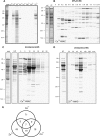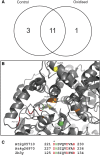Divalent metal ions in plant mitochondria and their role in interactions with proteins and oxidative stress-induced damage to respiratory function
- PMID: 20018591
- PMCID: PMC2815878
- DOI: 10.1104/pp.109.147942
Divalent metal ions in plant mitochondria and their role in interactions with proteins and oxidative stress-induced damage to respiratory function
Abstract
Understanding the metal ion content of plant mitochondria and metal ion interactions with the proteome are vital for insights into both normal respiratory function and the process of protein damage during oxidative stress. We have analyzed the metal content of isolated Arabidopsis (Arabidopsis thaliana) mitochondria, revealing a 26:8:6:1 molar ratio for iron:zinc:copper:manganese and trace amounts of cobalt and molybdenum. We show that selective changes occur in mitochondrial copper and iron content following in vivo and in vitro oxidative stresses. Immobilized metal affinity chromatography charged with Cu(2+), Zn(2+), and Co(2+) was used to identify over 100 mitochondrial proteins with metal-binding properties. There were strong correlations between the sets of immobilized metal affinity chromatography-interacting proteins, proteins predicted to contain metal-binding motifs, and protein sets known to be oxidized or degraded during abiotic stress. Mitochondrial respiratory chain pathways and matrix enzymes varied widely in their susceptibility to metal-induced loss of function, showing the selectivity of the process. A detailed study of oxidized residues and predicted metal interaction sites in the tricarboxylic acid cycle enzyme aconitase identified selective oxidation of residues in the active site and showed an approach for broader screening of functionally significant oxidation events in the mitochondrial proteome.
Figures



Similar articles
-
Loss of Lon1 in Arabidopsis changes the mitochondrial proteome leading to altered metabolite profiles and growth retardation without an accumulation of oxidative damage.Plant Physiol. 2012 Nov;160(3):1187-203. doi: 10.1104/pp.112.203711. Epub 2012 Sep 11. Plant Physiol. 2012. PMID: 22968828 Free PMC article.
-
Proteomic identification of divalent metal cation binding proteins in plant mitochondria.FEBS Lett. 2003 Feb 27;537(1-3):96-100. doi: 10.1016/s0014-5793(03)00101-7. FEBS Lett. 2003. PMID: 12606038
-
Experimental analysis of the rice mitochondrial proteome, its biogenesis, and heterogeneity.Plant Physiol. 2009 Feb;149(2):719-34. doi: 10.1104/pp.108.131300. Epub 2008 Nov 14. Plant Physiol. 2009. PMID: 19010998 Free PMC article.
-
Metals, toxicity and oxidative stress.Curr Med Chem. 2005;12(10):1161-208. doi: 10.2174/0929867053764635. Curr Med Chem. 2005. PMID: 15892631 Review.
-
Link of impaired metal ion homeostasis to mitochondrial dysfunction in neurons.Curr Opin Chem Biol. 2018 Apr;43:8-14. doi: 10.1016/j.cbpa.2017.09.009. Epub 2017 Oct 28. Curr Opin Chem Biol. 2018. PMID: 29100100 Review.
Cited by
-
Thiol-based redox proteins in abscisic acid and methyl jasmonate signaling in Brassica napus guard cells.Plant J. 2014 May;78(3):491-515. doi: 10.1111/tpj.12490. Epub 2014 Apr 15. Plant J. 2014. PMID: 24580573 Free PMC article.
-
A Combined N-terminomics and Shotgun Proteomics Approach to Investigate the Responses of Human Cells to Rapamycin and Zinc at the Mitochondrial Level.Mol Cell Proteomics. 2019 Jun;18(6):1085-1095. doi: 10.1074/mcp.RA118.001269. Epub 2019 Mar 15. Mol Cell Proteomics. 2019. PMID: 31154437 Free PMC article.
-
TsNAC1 Is a Key Transcription Factor in Abiotic Stress Resistance and Growth.Plant Physiol. 2018 Jan;176(1):742-756. doi: 10.1104/pp.17.01089. Epub 2017 Nov 9. Plant Physiol. 2018. PMID: 29122985 Free PMC article.
-
Alternative oxidase: a mitochondrial respiratory pathway to maintain metabolic and signaling homeostasis during abiotic and biotic stress in plants.Int J Mol Sci. 2013 Mar 26;14(4):6805-47. doi: 10.3390/ijms14046805. Int J Mol Sci. 2013. PMID: 23531539 Free PMC article. Review.
-
Horizontal gene transfer of the Mer operon is associated with large effects on the transcriptome and increased tolerance to mercury in nitrogen-fixing bacteria.BMC Microbiol. 2024 Jul 6;24(1):247. doi: 10.1186/s12866-024-03391-5. BMC Microbiol. 2024. PMID: 38971740 Free PMC article.
References
-
- Alscher RG, Erturk N, Heath LS (2002) Role of superoxide dismutases (SODs) in controlling oxidative stress in plants. J Exp Bot 53 1331–1341 - PubMed
-
- Andreini C, Banci L, Bertini I, Rosato A (2008) Occurrence of copper proteins through the three domains of life: a bioinformatic approach. J Proteome Res 7 209–216 - PubMed
-
- Bartoli CG, Gomez F, Martinez DE, Guiamet JJ (2004) Mitochondria are the main target for oxidative damage in leaves of wheat (Triticum aestivum L.). J Exp Bot 55 1663–1669 - PubMed
-
- Baxter I, Muthukumar B, Park HC, Buchner P, Lahner B, Danku J, Zhao K, Lee J, Hawkesford MJ, Guerinot ML, et al (2008) Variation in molybdenum content across broadly distributed populations of Arabidopsis thaliana is controlled by a mitochondrial molybdenum transporter (MOT1). PLoS Genet 4 e1000004. - PMC - PubMed
Publication types
MeSH terms
Substances
LinkOut - more resources
Full Text Sources
Molecular Biology Databases

